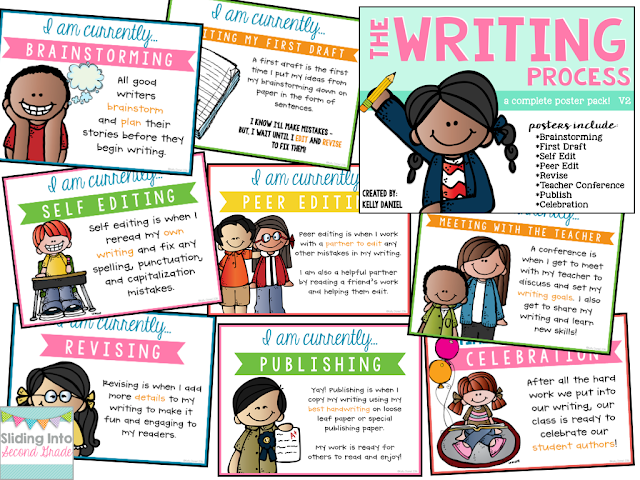Writers Workshop has always been a subject where I really see students struggle and I am always looking for ways to engage my kiddos and reveal to them the creativity that is hiding inside. Every year I am always excited to launch my workshop and one way I do that is by teaching my kids about the process in which writers go through in order to publish great work.
In kindergarten and 1st grade, typically students learn to form sentences using proper spelling and making sure their work begins with a capital and ends with punctuation. By second grade students are expected by the end of the year to write paragraphs. What a leap!
This writing process poster set doubles as a teaching resource when launching your writers workshop, but it becomes a clip chart and usable part of your writing block! Here’s how!
Brainstorming
This step teaches students that they must plan out their ideas using graphic organizers. This gives teachers an opportunity to expose students to various organizers depending on the writing they’re wanting to create.
First Draft
The first draft is the starting point in a student’s writing where they are putting multiple sentences together to form paragraphs. They learn to write and get their ideas down on paper and worry about fixing any mistakes later in the writing process.
Self Editing
Editing ones work is an important skill that students will learn and will help them become productive partners in the peer editing step that comes next. Editing requires students to look for those spelling, capitalization, and punctuation mistakes in their work. This is also a time where teachers have the opportunity to show students the resources they can use to enhance their writing such as children’s dictionaries, classroom word walls, etc.
Peer Editing
Now students are able to help each other by reading over their peer’s work and help them fix any mistakes they find in their writing. It allows them to share their work and openly discuss their ideas.
Revising
Like editing, revising can be tricky for students since it requires them to add details to their writing for it to become more engaging and concise to their readers. Often times it’s hard for students to think about how others understand their writing since they’re so in their own minds about their stories. However, this is always a fun step to teach them and one where I see the most growth once the light bulb goes off.
Teacher Conference {this step can be inserted anywhere in the writing process}
This is an extremely important step because it allows you to touch base with each child and see what they’re working on. It also allows you to work with them to set writing goals and share a skill for them to practice independently. Keep a writing conference binder where you can easily access your notes or keep copies of student work.
Publishing
Possibly the most exciting step for any child in the writing process- publishing! Not only does a child take pride in writing their final drafts, but with all the work they put into this piece they’re probably ready to be done with it and move on. Publishing has students write their final drafts in their best handwriting and it’s always fun to have special publishing paper at their disposal.
A Celebration!
This step isn’t necessary to teach, but I think it’s important for students to celebrate their work and have an opportunity to share their published work with their peers or even parents if you’re able to have a quarterly get-together. Seeing themselves as student-authors is an important step in building their confidence as writers and to prove that although everyone has different writing abilities, everyone has work they should be proud of!
It’s also great for me to glance over and see who has been stuck on one step for a while or those who seem to steamroll through their writing. I am able to conference, or touch base, with those kiddos and see what goals they need to establish in order to get the most out of their writing.



